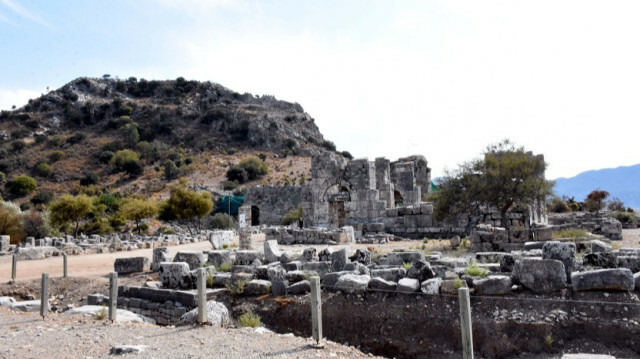
Ancient city was capital of 'Kaunos region' between Caria, Lycia until beginning of 4th century BC, according to UNESCO
The Byzantine church, tombs, and inscriptions were found during the excavations carried out in western Turkey's ancient city of Kaunos that was included on the UNESCO World Heritage Tentative List in 2014.
The ancient city is located in the town of Dalyan and on the right bank of the Dalyan Stream that connects Koycegiz Lake to the Mediterranean Sea.
According to UNESCO, it was the capital of the "Kaunos region" between Caria and Lycia until the beginning of the 4th BC.
In today’s context, the coastal area starting from the south plains of the Aegean resort province of Mugla and extending till the mountains between Mugla and the Mediterranean Antalya province was under the sovereignty of Kaunos that kept these borders until the 4th century BC but then lost its statue of the sovereign state after the Persian invasion.
The city was constructed on terraces -- significant religious structures like Baselius Kaunios Temple, Apollon Sanctuary, and Demeter Sacred Rocks on one side and bath, theatre, and other structures including Palaestra on a large terrace called the Upper City, on the other.
Following a 10-minute journey by tour boat and walking for 15 minutes through the woods, the visitors can reach the place that opens the doors of the 3,000-year-old civilization.
The 2,400-year-old rock tombs and a 5,000-seat ancient theater welcome the visitors to the area.
Visitors walking around the basilica, bath, and agora can also examine the 1,300-year-old mosaics and take photos at the sacred Temple of Demeter.
The excavations that started in the region with the efforts of Baki Ogun in 1966 were later led under the chairmanship of his student Cengiz Isik, and lasted until 2020.
Isik's student Ufuk Cortuk took over the excavations' chairmanship this year.
Speaking to Anadolu Agency, Cortuk said the ancient city became famous for many "first breakthroughs," such as the rotary curtain system in the ancient theatre, the piggy bank for donations to the gods, world-famous rock tombs, as well as the Carian-Greek bilingual inscriptions.
He emphasized that the excavations in Kaunos have been carried on by the Turkish scientific delegation for the past 55 years.
"Excavations in the ancient city have been taking place in the Roman basilica bordering the western side of the port agora for the last three years. During the excavations we carried out in the basilica, which dates back to the 2nd century AD, we encountered a Byzantine church," Cortuk said.
He explained that the Roman basilica is a gigantic structure, 98 meters (321.5 feet) long and 22 meters (72 feet) wide.
"We continue the excavations in the church that was unearthed. During our work in the church, we came across the tomb, which most likely belongs to the church's high priest, and has very fine workmanship. This tomb contains at least three-four burials in a row. So, it has a very interesting structure," Cortuk said.
He went on to say that two more graves -- Byzantine tombs -- were found in the place adjacent to the western wall of the church.
The excavations head underlined that two huge blocks were also unearthed in the eastern part of the church.
"There are inscriptions on them. It is among the important troves of this year. Work is underway to fully understand the inscription," he said, adding that the Greek inscription "is not so easy" to read.
Kaunos "sheds light on the unknowns of archeology" and very important historical structures were unearthed in the city in half a century, Cortuk also noted.


